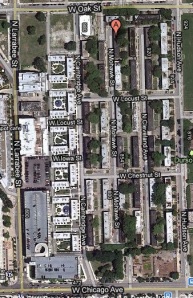
So long, Cabrini Green
April 11, 2011by Sarah Michele Ford
It seems innocuous enough… an apartment complex just northwest of downtown Chicago, constructed between 1942 and 1962, a nd home to approximately 15,000 people. But Cabrini Green wasn’t an ordinary apartment complex; to many, it represented everything that was wrong with public housing in American cities. Cabrini Green was the scene of countless acts of violence over the course of its decades as a predominantly poor, predominantly African American public housing complex. Cabrini Green stood until last month, when the last of the high rise building was demolished. During that time, Cabrini stood not just as public housing, but as a symbol of the problems of public housing in America’s cities.
nd home to approximately 15,000 people. But Cabrini Green wasn’t an ordinary apartment complex; to many, it represented everything that was wrong with public housing in American cities. Cabrini Green was the scene of countless acts of violence over the course of its decades as a predominantly poor, predominantly African American public housing complex. Cabrini Green stood until last month, when the last of the high rise building was demolished. During that time, Cabrini stood not just as public housing, but as a symbol of the problems of public housing in America’s cities.
The city, the plight and living conditions of the urban poor, has been a central focus of American sociology, and in fact Chicago itself has been the subject of more than its share of urban sociology, beginning in the early part of the twentieth century with the Chicago school. So how would a sociologist approach the question of Cabrini Green?
A sociologist would look at Cabrini Green and see both symptom and problem. Cabrini Green, and housing projects in general, concentrated poor people, concentrated minorities, into one place. On the one hand, this made it more possible to deliver social services. On the other hand, because the urban poor are overwhelmingly African American, it effectively imposed racial segregation and exacerbated the very inner-city problems – gang violence, crushing poverty – that marred the lifetime of Cabrini Green. These are the causes. But it’s not that simple… because Cabrini Green was also a symptom. A symptom of racial prejudice, of fear of the poor and of urban violence.
What would be a better option? How can we better deal with the problems of the inner city?
What could have been built instead? Would it be possible to offer racially integrated housing by building government subsidized housing in non-African American communities in single family dwellings in a hope to create a racial diverse mixture. You describe how Cabrini Green imposed racial barriers. What could have been done to circumvent this?
Hugh Floyd